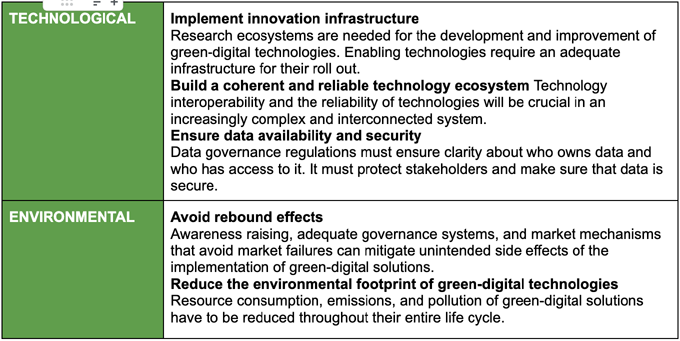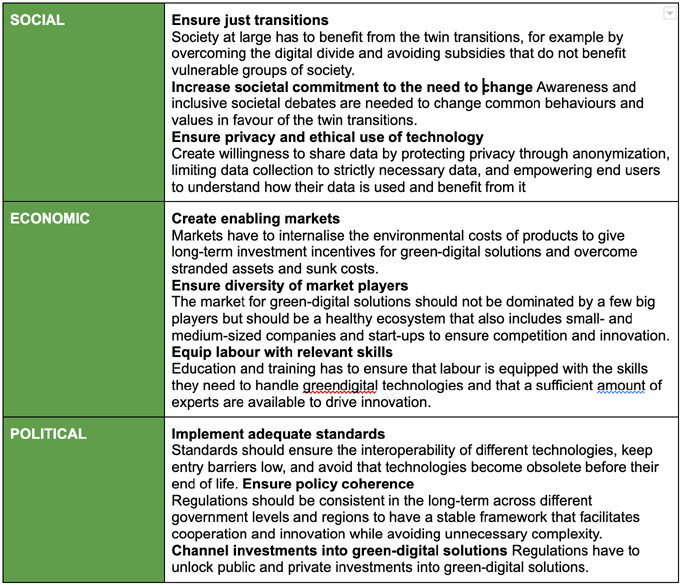
Justin Anderson
ESG Technology, Innovation | Former Head of Technology CoE KPMG International
The ‘green transition’ is necessary to mitigate the consequences of climate change and the degradation of the environment. ‘Digital transformation’ has changed how business creates value and continues to transform the way we live. Successfully managing the green and digital ‘twin’ transitions is the cornerstone for delivering a sustainable, fair, and competitive future (MUENCH et al., 2022)
This post is intended for forward-thinking leaders, technologists & policy makers. It explores how the green and digital transitions can reinforce each other and how digital technologies can contribute to fighting climate change and environmental degradation.
The climate crisis and the loss of biodiversity are clearly linked to human activities. The consequences of this crisis pose an existential threat globally. The way out lies in a swift and inclusive transition to environmentally sustainable lifestyles and economies. The green transition refers to the fundamental shift in production and consumption patterns to allow us to live within planetary boundaries.It means mitigating climate change by introducing climate-friendly lifestyles and taking environmental costs into account. It includes addressing the loss of biodiversity and its multiple ecosystem services that are crucial to healthy living and resilient societies. At the same time, the green transition must be fair and inclusive.
Digital technologies provide functions that can catalyse the green transition.
Monitoring and tracking can provide real-time information and be a catalyst for the circular economy. Simulation and forecasting can improve efficiency, for example in the form of Digital Twins that can simulate the entire life cycle of a product or process. Virtualisation of production and consumption changes sectors and reduces environmental impact by moving economic activities online, especially if the digital technologies are energy-efficient and circular.
Using digital technologies, systems management can cope with an increasing complexity while optimising operations, for example in smart cities. Lastly, digital information and communication technologies enable new levels of interaction. Data and data analysis will be the backbone of the green and digital transitions. Modern information and communication technologies, such as sensors, can help to collect and disseminate such data.
Digital technologies can support the green transition in different ways depending on the sector.
For example:
- Agriculture sector, better systems management can increase agricultural productivity through more accurate applications of feed, water, energy, fertilizers, and pesticides.
- Buildings and construction sector, virtualisation can entirely eliminate certain space needs, for example through remote meetings or online shopping.
- Energy sector, digital information and communication technologies facilitate communication between stakeholders and technical elements in an increasingly complex energy system.
- Energy-intensive industries, monitoring and tracking provides information on the parts and materials used in products to enable better maintenance, increased recycling, and reuse.
- Mobility and transport sector, simulation and forecasting can help optimise traffic flows to limit congestion and pollution.
While green and digital technologies will play a major role in the ‘green transition’, their implementation will depend on several economic, social, and political factors. The twin transitions depend on a range of contextual factors that must be carefully considered.
- Economic factors include the costs of the twin transitions, the economic opportunities created by the twin transitions, the shift of jobs between growing and declining sectors, and the financing of the necessary investments.
- Social factors include acceptance, fairness, and behavioural change.
- Political factors include regulatory frameworks, standards and geopolitical aspects.
The green and digital technologies necessary for the twin transitions can only be rolled out at scale if these contextual factors are managed appropriately.
The twin transitions rely on interoperable technologies and the willingness to share data, which is why data privacy and security are crucial. Research ecosystems are important for the development and improvement of technologies. Without an adequate infrastructure, the roll out of new technologies cannot take place. Moreover, societal commitment to the need to change is fundamental for the success of the twin transitions.
A just transition is crucial for widespread acceptance of green-digital solutions. Social awareness could avoid rebound effects, such as increased consumption as a result of efficiency gains and cost savings. The labour force requires new skills for the green and digital transitions, while markets should internalise the environmental costs of products. The presence of small- and medium-sized companies is essential for a competitive and innovative market of green-digital solutions. Finally, there is a need for policy coherence and increased investment into green-digital solutions, and the financing of innovation that reduces their environmental footprint.
The following two tables presents these key requirements in more detail.


The green and digital transitions will shape the future of our world. Both are at the top of the political agenda. It is imperative for both governments and business to consider how these trends will interact and what the possible tension points are.
The term ‘twin transitions’ refers not only to two concurrent transformational trends (the green and digital transitions); the term also refers to uniting the two transitions, which could accelerate necessary changes and bring societies closer to the level of transformation needed. To succeed with the green and digital transitions, a better understanding of the possibilities to link them is fundamental, especially when it comes to knowing what must be done most urgently.
Bibliography
MUENCH, S., STOERMER, E., JENSEN, K., ASIKAINEN, T., SALVI, M. and SCAPOLO, F., 2022. Towards a green & digital future. [online] JRC Publications Repository. Available at <https://publications.jrc.ec.europa.eu/repository/handle/JRC129319>
KeyFacts Energy: Commentary
 KEYFACT Energy
KEYFACT Energy